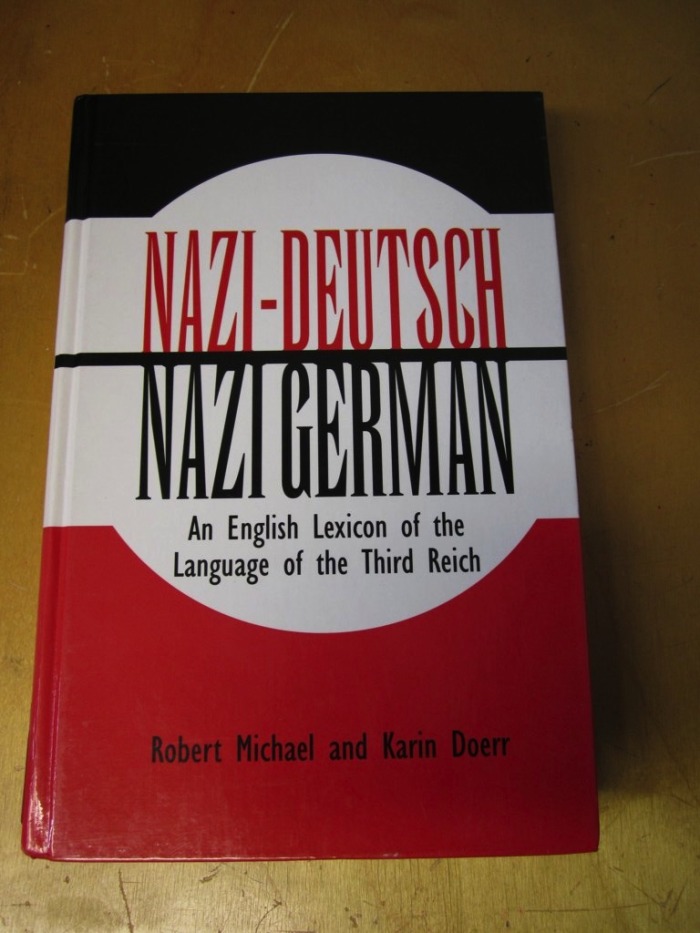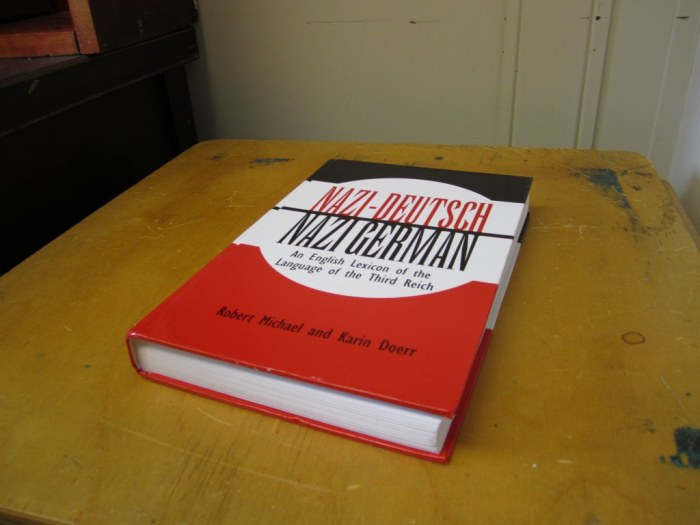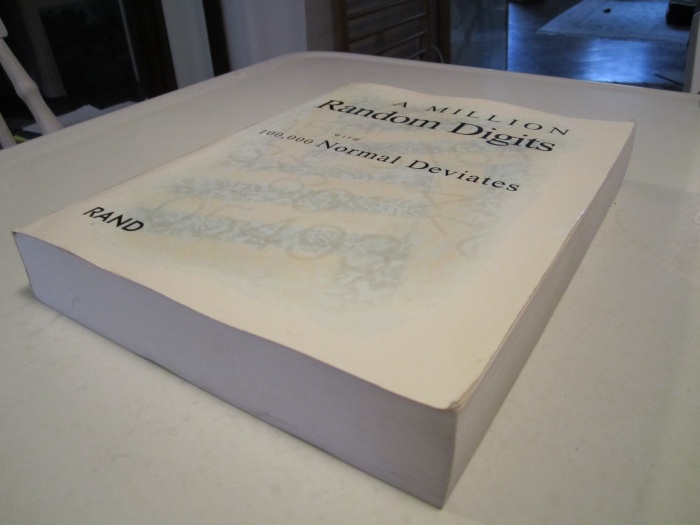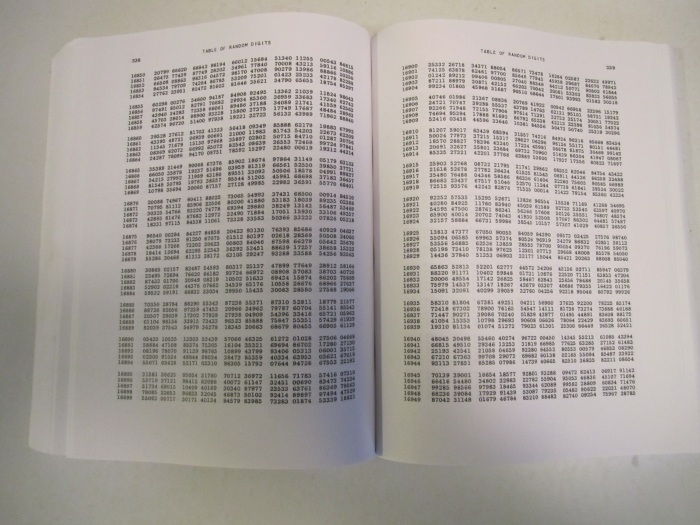Archive for the ‘War’ Category
Nazi-Deutsch/Nazi-German: An English Lexicon of the Language of the Third Reich
Maybe you are a professor of German culture. Or maybe, as a hobby, you research and reenact the major historical jargons of Europe. Or maybe you’re already thinking about this year’s Halloween costume and have considered dressing as a Nazi, so that everyone at the party can smile uncomfortably upon your entrance and then, several drinks later, finally take you aside and tell you just how far beyond the pale you have wandered this year—this, as you gaze across the room at the two smiling Maos, welcome in the fold.
If any of the above is true, this wonderful bilingual glossary, Nazi-Deutsche/Nazi-German: An English Lexicon of the Language of the Third Reich, might be just the thing for you. Written by Robert Michael and Karin Doerr, this surprisingly manageable volume provides all you need to know about the various slang words, bureaucratic nomenclatures, and military terms of art the Nazis bandied about during their murderous rampage. It will surely help you to interpret those obscure archival documents you’ve stumbled across, or at last to make sense of those letters grandma saved from great great uncle Wilhelm, or even, come October, to make your own guttural pronouncements one measure more authentic.
Having written their reference clear through the Zs, Michael and Doerr can now, unlike most lexicographers, rest in the comfort of a task completed. Whereas most dictionaries of modern language will demand constant revision and expansion to keep abreast of changing verbiage, the language of the Nazis is more or less done with evolving. It may be fitting, then, that the authors introduce their lexicon with two definitive essays on the ideology of the jargon of the Third Reich. Their passion for the subject really comes through in the essay titles: “Nazi-Deutsch: An Ideological Language of Exclusion, Domination, and Annihilation,” by Doerr, and “The Tradition of Anti-Jewish Language,” by Michael. It should come as no surprise that the ideological gist of Nazi jargon is rather an open-and-shut case, but the authors make the assessment especially cutting and clear. As Doerr puts it at the start of her essay, “German, as it changed during the Third Reich period, represents a deviation from human and humanistic language development and a violation of civil interaction and even the meaning of speech.” The sinister black and red cladding drives home this point: Nazi language barely even qualifies as a mode of human communication. We the humanists spend plenty of time learning that language is a pure texture of ideology and difference, but few are the occasions for summing up an entire lexicon in two tidy essays. Michael and Doerr bring off their anti-Nazi pronouncements with rare verve and aplomb.
A Million Random Digits with 100,000 Normal Deviates
First published for the RAND Corporation in 1955 by the Free Press of Glencoe, Illinois, A Million Random Digits with 100,000 Normal Deviates contains exactly what you’d suspect: an extremely large table of random digits. One can hardly resist the impulse to open this hefty volume, but good luck actually reading it. Viz.:
Production of the so-called RAND Book began at the Los Alamos National Laboratory in 1947. Scientists there were developing a new branch of mathematics called the Monte Carlo Method, which uses random sampling to model complex systems. As it happened, the main complex system in need of modeling was the chaotic reaction inside the thermonuclear weapons that RAND scientists were then helping to design at Los Alamos. Of course, this is one of several important random number tables, but its connection with Cold-War weaponization is particularly interesting. Stanislaw Ulam is credited with the initial idea for Monte Carlo mathematics, and he developed it in collaboration with John von Neumann and the astoundingly named Nicholas Metropolis. Enrico Fermi had already used random sampling techniques in some of his experiments at the University of Chicago in the 1930s, but only in the late 1940s and 1950s at Los Alamos would they become formalized and see routine use. As the Introduction to the first edition puts it, “the applications required a large supply of random digits or normal deviates of high quality,” and the RAND Book was produced to answer this need. It was created using an electronic roulette wheel in conjunction with a random-frequency pulse. The random pulse likely was a gas noise tube, though as Tom Jennings’s wonderful reconstruction proves, a geiger counter trained on uranium ore would have worked equally well—while also lending the whole affair a delightful circularity. (Jennings has previously reviewed the first edition of the RAND Book.) Monte Carlo mathematics has since become important for complex systems theory, chaos math, environmental science, and a variety of other disciplines, and the RAND Book remains among the most trusted and widely used tables of random digits. A copy is now available online, but for those who prefer to feel this volume’s heft in their hot little hands, the RAND Corporation graciously issued a second edition in 2001, available on Amazon. The tables themselves remain unchanged, of course—in fact, like the first edition, they were not conventionally typeset but reproduced directly from computer printouts, by photo-offset, in order to avoid typographical errors. The new edition does, however, provide an updated Foreword in celebration of this very strange book. Also available is a thrilling sequel
by David Dubowski, who uses computer algorithms to provide an equally large table, now with more perfectly random distribution—whatever that means.



